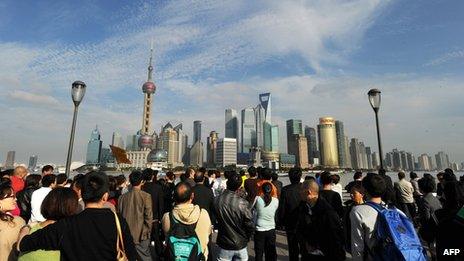China's economic growth picks up
- Published

China's economy picked up speed in the April-to-June quarter, a sign that the government's stimulus moves have started to have an impact.
The world's second-largest economy expanded 7.5%, from a year ago, up from 7.4% growth in the previous quarter.
Other data released on Wednesday showed that retail sales and factory output also rose in June.
The data comes as China has introduced a series of measures in recent months to help boost its growth.
"The result is very good and shows the economy has recovered very well in the second quarter," said Dariusz Kowalczyk, a senior economist with Credit Agricole in Hong Kong.
Growth boost
After years of robust expansion, China's economic growth rate has slowed in recent times, in part due to a decline in demand for its exports from key markets.
Prompted by the slowdown, China has been trying to boost domestic consumption to sustain its expansion and also to rebalance its growth model.
Last month, China's central bank said it would cut the reserve requirement ratio (RRR) - the amount of cash banks needs to keep in reserve - for banks engaged in lending to agriculture-related businesses and small companies to make more cash available for lending.
It said it would also encourage banks to lend more to exporters to boost shipments.
In April, the government said it would cut taxes on small firms and speed up the construction of railway lines across the country.
The government has also announced plans to build railways, roads and airports along the Yangtze River - which connects China's less developed inland provinces to Shanghai.
'Targeted stimulus'
Data released over the past few weeks has indicated the moves have started to have a positive effect on growth.
Earlier this month, China reported that its manufacturing activity grew at its fastest pace for six months in June.
On Wednesday, it said that factory output rose 9.2% in June, from a year earlier, while fixed asset investment jumped 17.3% in the first six months of the year.
Meanwhile, retail sales in June were 12.4% higher than a year ago, indicating that domestic consumption was picking up.
Mr Kowalczyk said the "noticeable improvement" in industrial production and fixed asset investment was due to "the targeted stimulus measures undertaken by the Chinese authorities".
Stimulus dependent?
However, Chang Jian, an analyst with Barclays, suggested that while the latest growth numbers were in line with expectations, "the underlying momentum and recovery is still in a fragile state".
She cited the recent slowdown in China's property market - a key contributor to its growth - as an area of concern.
"The biggest risk for the second half is property correction and related financial risks," she said.
Ms Chang also added that "the recovery is quite dependent on government support".
"So, I think the government can choose either to tolerate lower growth, or to achieve the growth target they just have to do more stimulus."
She said she expects the policymakers to cut interest rates in the coming months and take steps to "boost infrastructure spending and to support consumption growth".
China has set a growth target of 7.5% for 2014.
- Published10 July 2014
- Published1 July 2014
- Published12 June 2014